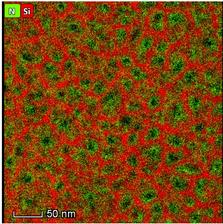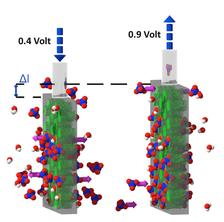The distribution of artificial muscles (green) in silicon (red) under the electron microscope. (Credit: Brinker et al., Sci. Adv. 2020; 6 : eaba1483, CC BY 4.0 [Source])
A research team from Hamburg, including from DESY, has succeeded in giving silicon muscle power. This new property enables the material to convert electrical signals into mechanical movements for the first time. At DESY's X-ray source PETRA III, the team led by Patrick Huber from Hamburg University of Technology (TU Hamburg) could monitor the movement of the silicon atoms live. The new hybrid material offers completely new perspectives for the chip-based technologies of tomorrow, as the team reports in the journal Science Advances.
Smartphones, laptops, smart watches: The chemical element silicon is found in every electronic component and computer chip, no matter how small. However, there are tasks that silicon can not master. For instance, in order for the loudspeaker in a smartphone to work, so-called actuator materials are required. These perform small movements in the micrometer and nanometer ranges electrically and very precisely, causing air, for example, to vibrate. Until now, silicon could not perform such functions.
“To change this, we artificially imitated what nature has already achieved in biomaterials such as bones or teeth through a clever combination of soft and hard matter,” explains Huber. For this purpose, his team equipped the small nanocanals in hard silicon, which can form spontaneously in huge numbers, with the artificial, environmentally friendly and soft muscle polymer polypyrrole. “We have succeeded in causing these muscle molecules and thus the entire silicon skeleton of the hybrid material to expand under electric voltage and then contract again,” explains the physicist.
What is particularly exciting about the new material is that in an aqueous environment only very small electrical voltages are required for the actuator function. They are similar in magnitude to those used in many living systems to conduct stimuli and control movement. “This makes the hybrid material particularly promising for applications in biological or bio-medical systems,” explain Manuel Brinker, lead author of the paper, who worked together with co-author Guido Dittrich, both PhD students at the TU Hamburg.
“Furthermore, only biocompatible substances that are available in large quantities are used,” says co-author and PhD student Pirmin Lakner from the DESY NanoLab. “Above all, no environmentally harmful heavy metals, especially lead, as in many conventional actuator materials,” adds DESY scientist Thomas Keller, also a co-author from the NanoLab. As part of the cooperation with the TU researchers, both investigated the actuation of the same muscle molecules on planar silicon surfaces at PETRA III beamline P08.
“We were only able to understand the functioning of the new nanoporous hybrid material with the help of computer simulations of micromechanics. Now, however, we can precisely predict them and thus develop strategies to optimize them for applications,” adds Norbert Huber from the Helmholtz-Zentrum Geesthacht for Coastal and Materials Research, who led the analysis of the muscle function at the nanoscale. “In the mechanical functional analysis, we were helped above all by high-resolution electron microscopic images that made the small muscles in the hundreds of billions of nanopores per square centimeter of silicon visible,” adds Claudia Richter, one of Norbert Huber's doctoral students, who also worked with Tobias Krekeler from the Electron Microscopy Unit at the TU Hamburg.
Using DESY's PETRA III X-ray microscope, the authors have now even been able to observe live how, driven by the muscle molecules, the silicon atoms move back and forth in time with the small electrical voltages and how in detail this concerted movement at the nanoscale makes the deformation at the macroscale possible.
The new material design is an example of how the physics peculiar to the nanoscale can be combined with self-organization principles from the nano to the macro scales to give a classic base material of enormous technological importance a completely new functionality, i.e. muscle power. “It was a lot of fun in this interdisciplinary team to see how we can artificially imitate design principles for materials that nature has long used to achieve the fascinating variety of forms and functions of ‘living’ materials. We have thus developed a new type of hybrid base material with actuator properties that will enable us make tomorrow's technology more bio-inspired and thus more sustainable,” concludes lead researcher Patrick Huber.
In addition to silicon with muscles, many other new material systems are being explored in the Collaborative Research Center SFB 986 at the TU Hamburg. These are also part of the newly established Center for Integrated Multiscale Materials Systems, CIMMS for short, which received funding of almost four million euros over a total of four years from Hamburg’s Ministry of Science, Research, Equality and Districts in January 2020. In addition to the TU Hamburg, researchers from the University of Hamburg, DESY and Helmholtz-Zentrum Geesthacht are working together on the project. Patrick Huber recently became head of the research group “Physics of Materials and High-Resolution X-ray Analytics of the Structural Dynamics and Function of Matter” in CIMMS within a cooperative professorship between DESY and TUHH with a link to the Center for Hybrid Nanostructures CHyN at the University of Hamburg.
(Source: Press release from TU Hamburg on the new hybrid material / DESY news)
Reference (New hybrid material):
Giant electrochemical actuation in a nanoporous silicon-polypyrrole hybrid material; Manuel Brinker, Guido Dittrich, Claudia Richert, Pirmin Lakner, Tobias Krekeler, Thomas F. Keller, Norbert Huber, Patrick Huber; Science Advances, 2020; DOI: 10.1126/sciadv.aba1483








